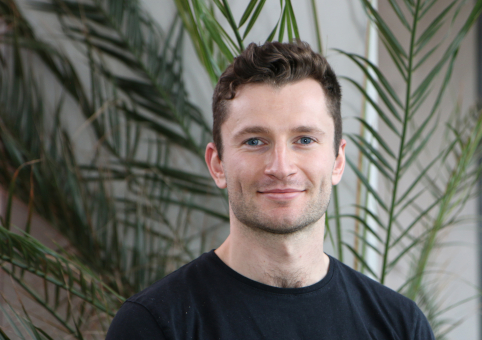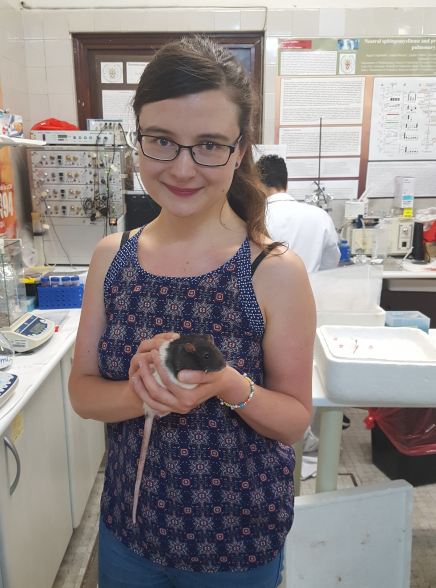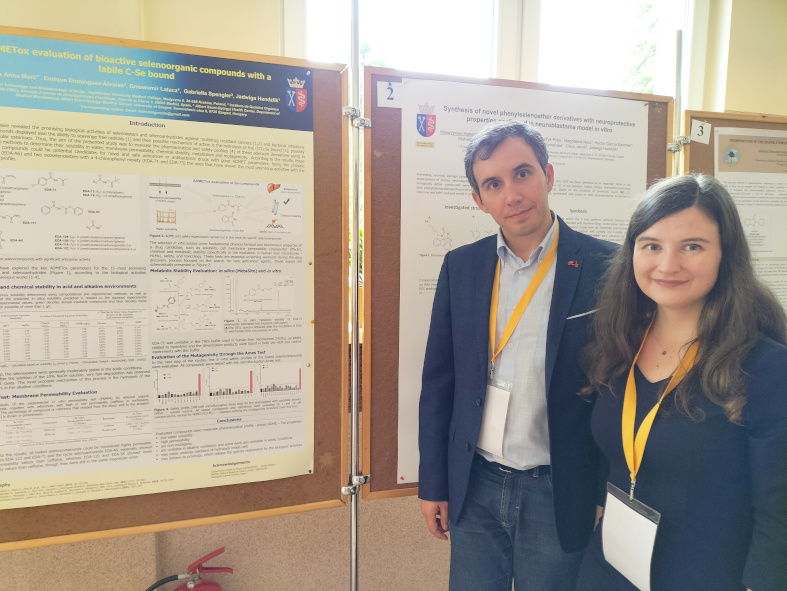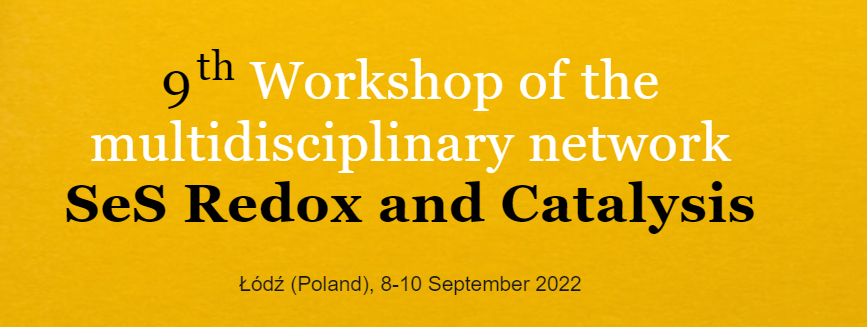PeerJ are delighted to announce the winners of two PeerJ Awards for Best Presentation and Best Poster at the 9th edition of the annual Workshop of the multidisciplinary network SeS Redox and Catalysis (WSes-9), this year held in Łódź, Poland.
SeS Redox and Catalysis is an international network for the development of multidisciplinary research projects connected to Selenium, Sulfur and other Redox Catalysts. The WSeS meetings are designed for Early Career Researchers, to give them the opportunity to present their research and results in a stimulating and multidisciplinary environment.
We recently caught up with the award winners to discuss their research:
Leander Crocker Leibniz-Forschungsinstitut für Molekulare Pharmakologie (FMP), Germany.
 Can you tell us a bit about yourself and your research interests?
Can you tell us a bit about yourself and your research interests?
I originally come from Exeter (UK) and first studied Chemistry at the University of Southampton where worked with Dr. Eugen Stulz on porphyrin-DNA conjugates for my Bachelor’s Thesis. After this, I carried out a Master’s Research Placement at the University of Toronto in Prof. Andrew Wooley’s group working on photoswitchable affinity proteins. I came back to England for my PhD research with Dr. Ljiljana Fruk at the University of Cambridge, where I developed nanostructured photocatalysts derived from riboflavin (vitamin B2) for green catalysis applications. During this time, I developed a passion for photo-driven processes (catalysis, switching, uncaging etc.) and wanted to go deeper into the potential biomedical applications of these techniques.
What first interested you in this field of research?
I now work within the group of Prof. Christian Hackenberger at the FMP Berlin, where we develop new tools to modify proteins and peptides in order to study cellular functions and generate biopharmaceuticals such as antibody-drug conjugates. Specifically, my research focuses on developing novel light-driven bioconjugation techniques utilising organosulphur/selenium compounds. Thanks to the inherent redox properties of these chalcogens, we can utilise photoredox catalysis to enable conjugation reactions via single electron (radical) transfer pathways.
You won the Best Presentation Award at WSeS-9, can you briefly explain the research you presented?
At the WSeS-9 in Lodz, I presented our initial efforts to achieve chemoselective alpha-C(sp3)-H functionalisation on thio/seleno ethers for bioconjugation applications. We first took influence from MacMillan’s methionine conjugation methodology that elegantly utilised a flavin photocatalyst to conjugate various Michael acceptors to methionine (J. Am. Chem. Soc. 2020, 142, 51, 21260–21266). However, the method was limited by cysteine cross-reactivity due to the use of highly activated Michael acceptors. We therefore hypothesised that we may influence the selectivity of this reaction by tuning both the reactivity of the Michael acceptor and the reactivity of the radical generated on methionine by the photocatalyst. Our work so far has identified a vinyl phosphonate Michael acceptor to be more selective towards methionine than cysteine, which we aim to elaborate towards selective cell glycan labelling. Additionally, we prepared difluoroselenomethionine to investigate whether radical reactivity could be tuned towards different olefins by the influence of adjacent fluorine atoms. Unexpectedly, we mainly observed the results of a deselenylation reaction, rather than the expected conjugation products.
How will you continue to build on this research?
Looking forward, we will continue to investigate thio/selenoether-containing derivatives towards selective bioconjugation strategies, such as within cell glycan labelling, and the use of diselenides as a photolabelling reagent of unnatural tyrosine derivatives. I look forward to meeting and discussing ideas once again with the fantastic WSeS community in the near future!
Małgorzata Anna Marć Jagiellonian University Medical College, Poland.
 Can you tell us a bit about yourself and your research interests?
Can you tell us a bit about yourself and your research interests?
I obtained my PhD in Pharmaceutical Sciences from Jagiellonian University Medical College (Kraków, Poland) in the pharmaceutical biotechnology field. In particular, I worked on cancer research, drug discovery, and the ADMET (Absorption, Distribution, Metabolism, Excretion, Toxicology) aspects of potential drug candidates. Moreover, in my research, I applied alternative methods related to drug safety and metabolism.
And about your research experience?
I have worked in four countries (Spain, Poland, Hungary, Italy), and in both academia and in industry, providing me with a comprehensive overview of scientific research in the fields of the biomedicine and the drug discovery. Amidst the different techniques I have handled, my favourite is the pharmacological and ADMET evaluation of novel organic compounds as novel anticancer/antimicrobial agents, being the selenocompounds and the hydantoins the ones in which I have gained more expertise.
Currently I am employed by Olimp Laboratories, a pharmaceutical company in Pustynia, Poland that focuses on nutrition and dietary products. I work in the development of new products, but due to confidentiality issues I am unable to give more information!
What first interested you in this field of research?
The determination of ADMET parameters is of critical importance for the success of drug candidates in preclinical studies on new drug candidates, as they affect their oral bioavailability, metabolism, and clearance. Safety assessment and toxicological profiling are essential screening elements during the drug discovery process. These evaluations are very important because the new drugs must not only be active: they must also be safe and their ADMET parameters must be within the acceptable range for compounds that can be used for therapeutic applications. I really like being involved in this process, because for me it is fulfilling to help in the selection of what compounds are both active and safe, and in the removal of those that could be a risk for the patient. Regarding the research that I have performed; both the novel selenium- or hydantoin-containing derivatives can be used as potential adjuvants in future cancer therapies.
You won the Best Poster Award at WSeS-9, can you briefly explain the research you presented??
I presented the poster “ADMETox evaluation of bioactive selenoorganic compounds with a labile C-Se bound”. This poster is a graphical summary of an article recently published in the journal Pharmaceutics, in the article “Pharmaceutical and safety profile evaluation of novel selenocompounds with noteworthy anticancer activity”. This work gathers the ADMETox assessment of these compounds, which was performed in my PhD thesis.

Previous works have revealed the promising biological activities of selenoesters and selenoanhydrides against multidrug resistant cancers and bacterial infections. Those compounds also displayed the ability to scavenge free radicals and their possible mechanism of action is the hydrolysis of the (CO)-Se bound, possibly catalyzed by cellular esterases. Thus, the aim of the presented study was to evaluate the pharmaceutical and safety profiles of these selenium derivatives using in silico and in vitro methods to determine their solubility in water, membrane permeability, chemical stability, metabolism, and mutagenicity. According to the results, these tested selenium compounds could be potential candidates for novel and safe anticancer or antibacterial drugs with good ADMET parameters, as they have an appropriate solubility, a good permeability and they are devoid of mutagenic potential.
How will you continue to build on this research?
I would like to continue developing new cutting-edge research challenges in the field of cancer research and biomedicine because this topic interests me very much and has great potential. Although I am open to other fields as microbiology, nutrition and molecular biology, I prefer cancer research, and in particular the ADMET evaluation.
My personal goal is to improve my professional research experience, acquire new scientific and interpersonal skills, and have the opportunity to lead my own group in the near future. It will be a great opportunity to establish a new network of contacts, increase my employability, chances for scientific work in a professional research institute or at a pharmaceutical company, and to develop my research passions.
Finally, I wanted to thank you a lot for awarding me this prestigious PeerJ award, it has been a big honor for me. I hope that soon I will be able to publish another part of my research in one of your journals.

